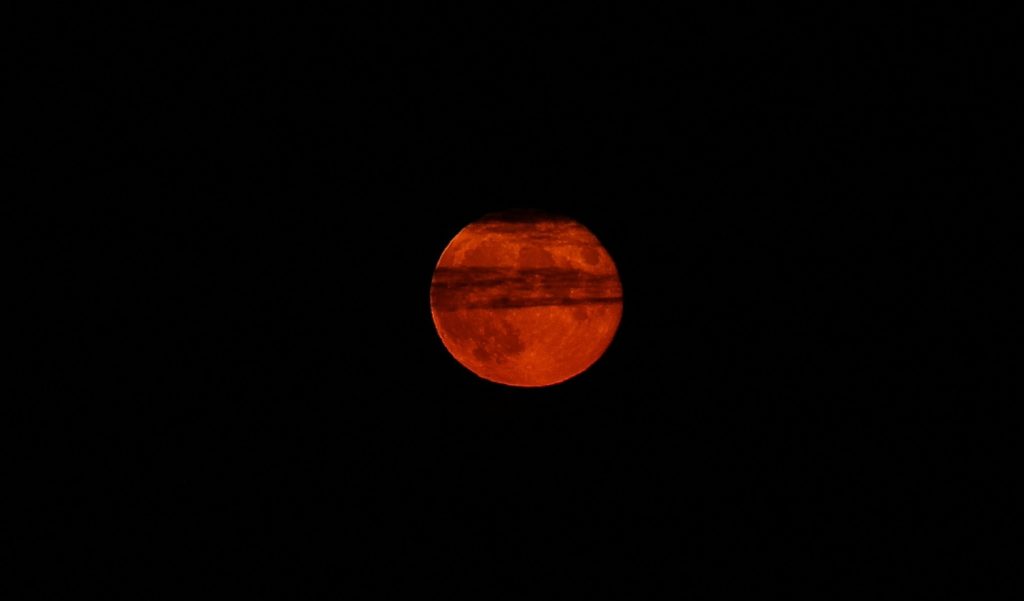
I decided to add something new to the Weird Holidays & Observances section this year: Full Moon Names and Dates.
Last year’s total solar eclipse piqued my interest in astronomy, a subject that’s always haunted me. It all stems from my inability to memorize the planets. I can’t keep them straight, nor can I remember their order. I fail those questions every time during cruise trivia.
And let’s not even talk about Astronomy 101 in college. I almost failed. (Humiliating when you go to a school renowned for its astronomy program. But slightly less because it wasn’t my major.)
Yet, I do find the sun, moon, and stars fascinating. Maybe especially the moon. I’m a firm believer that when it’s big and bright, it has a strange effect on people.
Maybe the TV news weather people always pointed out supermoons and moon names and I just never paid attention. The past couple of years, though, I have.
A Moon By Any Other Name…
It’s the names that fascinate me the most. I think because the names are often so poetic. Because each month’s moon may have a different name, depending on culture.
For instance:
- January is known as the Wolf Moon, but also the Winter Moon by Colonial Americans, the Cold Moon by the Cherokees, and the Quite Moon by the Celtics.
- The Cherokee call February’s moon the Bony Moon.
- The Neo Pagans label March’s moon the Death Moon.
- October is known as the Blood Moon by English Medieval and Neo Pagans.
Just to name a few.
I used the names listed on Space.com for the Weird Holidays & Observances page. That’s how I learned about a rare occurrence that will take place on January 31, 2018: a Super Blue-Blood Moon Lunar Eclipse.
Rare Moon Rising Trifecta
When there are two full moons in a month, the second one is known as a Blue Moon. That’s happening in January (and again in March).
The first full moon in January, on the 1st, was a supermoon. The second one will be too, because as Space.com explained: “…the moon arrives at perigee close to reaching its fullest phase.”
However, something only happening during the full moon on January 31, 2018 is a total lunar eclipse.
Such a Blue Moon total lunar eclipse has not occurred for 152 years, our skywatching columnist Joe Rao has found.
Hence the mouthful moniker, Super Blue-Blood Moon Lunar Eclipse.
One More Name
As if the full moon on January 31, 2018 hadn’t already hit the jackpot, it also acquires one more title: February’s full moon name, Snow Moon.
Why?
Because there is no full moon in February.
Interesting stuff, right? (If you don’t agree, just humor me. But if you made it this far, I’m thinking you’re at least a little intrigued too.)
Video
Here’s a Ripl video I put together about some of the names and how you can now find full moon dates and times in the Weird Holidays & Observances section.
Because full moon names are so fascinating, we added a new section just for them to our Weird Holidays & Observances section. #fullmoon #fullmoons #fullmoonnames #fullmoonrising #weirddays #hauntjaunts
Courtney Mroch is a globe-trotting restless spirit who’s both possessed by wanderlust and the spirit of adventure, and obsessed with true crime, horror, the paranormal, and weird days. Perhaps it has something to do with her genes? She is related to occult royalty, after all. Marie Laveau, the famous Voodoo practitioner of New Orleans, is one of her ancestors. (Yes, really! As explained here.) That could also explain her infatuation with skeletons.
Speaking of mystical, to learn how Courtney channeled her battle with cancer to conjure up this site, check out HJ’s Origin Story.
